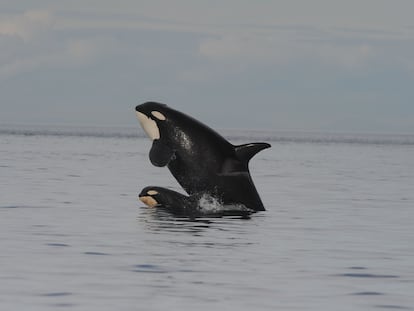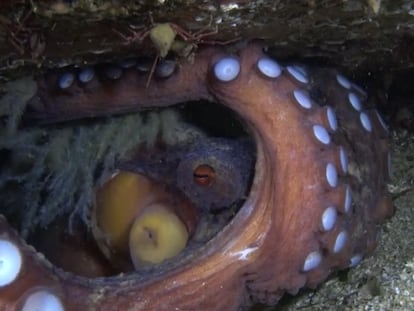How do bees learn to dance? By watching their elders
The complex movements that these insects use to indicate the location of new flowers are passed from generation to generation

Just like children are born with an innate ability to speak, bees carry dance in their genes, a skill they use to inform the hive that they found food. However, — also just like children, who need to be taught to speak properly — young bees need to learn how to dance well. Now, a group of entomologists has discovered that, without the example of their elders, honey bees are unable to transmit how far away new flowers are. This would indicate that these insects learn socially (like humans) a language on which their survival depends.
A century ago, Austrian biologist Karl Ritter von Frisch (the father of ethology, the study of animal behavior) discovered that bees danced for their hive mates. The best part is that this dance contained the instructions to reach a new field of flowers found by the explorer. Data like direction, distance, relative position of the Sun and amount of food was encoded in their “steps.” Many colleagues mocked von Frisch. In the 1920s and 1930s, to argue that insects had enough brains to store such complex spatial information and, moreover, to be able to communicate it with a symbolic language, was enough to deserve scientific excommunication. However, other entomologists confirmed his discovery in the following decades, and half a century later, in 1973, the Swedish Academy awarded him the Nobel Prize in Physiology for deciphering the dance of bees. Now, new research has found that these insects use social learning to master this language.
After years of meticulous observation, von Fisch understood that when a forager bee finds a new source of food (or water, or propolis, or a new place to migrate) it flies to the hive and initiates a dance, the details of which will depend on the characteristics of the newly discovered resource. Bees have different moves, depending on how far the find is. The most complex one, the figure 8 dance, is performed when the distance is farther than 150 meters. The explorer carries out a succession of movements that would seem to trace that number. In the straight parts of the routine, the insect waggles its abdomen at great speed: the duration of that waggle tells the others the distance to the pollen and the nectar. The longer it lasts, the further the destination. But which way is it? To communicate this, the bee does the straight part of the dance at an angle that, related to the position of the sun, indicates the right direction. Then there is the repetition of the dance, which among other functions fulfills that of rating the finding; the more repetitions, the more flowers.
“Accuracy varies depending on the distance to the food source and the surface the bee is dancing on. The further away the food source is, the more accurate the dance will be. When the dance floor is less uniform, it is less precise,” biologist James Nieh from the University of California San Diego explained. Together with colleagues from the Chinese Academy of Sciences, Nieh created five colonies with approximately 2,800 bees. They were all collected while still in the pupal stage and moved into other hives, each with its own queen, but with no veteran mates. They did the same with another, similar amount, but accompanied by mature specimens, and identified dozens of them with markers. Then they placed a series of containers with sucrose dissolved in water at just over 150 meters. Bees live about 35 days; their first flight in search of food is made around day nine. As published in the journal Science, they saw that both the bees in the hives of the experiment and the control ones danced after finding the sweetener, which confirms that bees carry dance in their genes.
However, the bees that had never seen experienced foragers do it danced erratically, without properly conveying distance or location, while those on the control combs communicated their information with great precision. This suggests that, even if the ability to dance is genetic, its accuracy depends on social learning, that is, on the individual learning by observing or interacting with others. Nieh explains that, while social learning had already been shown to exist in bees and ants, the acquisition of a natural animal language of such complexity had never been proven before.
After 20 days had passed, they examined their dance again, hoping that their ability would have improved with experience. Shihao Dong, a researcher from the Xishuangbanna Tropical Botanical Garden in China and lead author of the study, explained: “[When the] bees were older and had experience of dance following and dancing, they significantly reduced divergence angle errors and produced more orderly dances.” But they were never able to produce normal distance encoding. The bees that never had elders to learn from kept communicating inaccurate, longer distances.
The fact that the knowledge is embedded in their genes represents an advantage, as there is no risk of the next generation losing it. However, there is also a great drawback: rigidity and invariability. “There can be big differences regarding where the food is in different environments. As a result, different species of bees have developed different dancing dialects,” explained Ken Tan, an entomologist from the Chinese Academy of Sciences and senior author of the study. They can even vary within the same species. “Researchers suspect that this variation is due to the fact that colonies, even of the same species, can live in very different environments,” added the Chinese scientist, who highlighted the relevance of social learning: “If learning a language is a way to face different environments, then perhaps each colony has a distance-related dialect that is adapted to its location and passed down from experienced to novice bees. If so, our bees without teachers may never have corrected their mistakes because they acquired, by themselves, a different dialect of distance.”
The social learning of behaviors or languages as complex as the dance of bees is not exclusive to them; just last week, another group of entomologists proved that bumblebees can solve puzzles. The authors of the study, published in PLoS Biology, trained several of them to solve a two-option puzzle, offering a very sweet prize. Once they learned how to solve it, they paired them up with other bumblebees. Seeing how they got sucrose, 98% of them repeated what the veterans were doing.
Lars Chittka, an entomologist from the Queen Mary University of London, is the senior author on the bumblebee paper. He has studied social learning (and teaching) in other eusocial insects like ants and bees, and points out that there are actually many behaviors that these animals acquire through social interaction. The author of the book The Mind of a Bee highlights that the new study shows that dancing may be embedded in the genes of the bees to a lesser extent than previously assumed. In addition, he says, the fact that bees can calibrate the coding of the dance from individual experience gives them much more flexibility and plasticity when communicating to various resources and habitat types.
A century ago von Frisch discovered the bee dance, but there was still more to learn. “I think he would be very pleased to know that researchers from all over the world continue his work,” said Nieh.
Sign up for our weekly newsletter to get more English-language news coverage from EL PAÍS USA Edition
Tu suscripción se está usando en otro dispositivo
¿Quieres añadir otro usuario a tu suscripción?
Si continúas leyendo en este dispositivo, no se podrá leer en el otro.
FlechaTu suscripción se está usando en otro dispositivo y solo puedes acceder a EL PAÍS desde un dispositivo a la vez.
Si quieres compartir tu cuenta, cambia tu suscripción a la modalidad Premium, así podrás añadir otro usuario. Cada uno accederá con su propia cuenta de email, lo que os permitirá personalizar vuestra experiencia en EL PAÍS.
¿Tienes una suscripción de empresa? Accede aquí para contratar más cuentas.
En el caso de no saber quién está usando tu cuenta, te recomendamos cambiar tu contraseña aquí.
Si decides continuar compartiendo tu cuenta, este mensaje se mostrará en tu dispositivo y en el de la otra persona que está usando tu cuenta de forma indefinida, afectando a tu experiencia de lectura. Puedes consultar aquí los términos y condiciones de la suscripción digital.











































